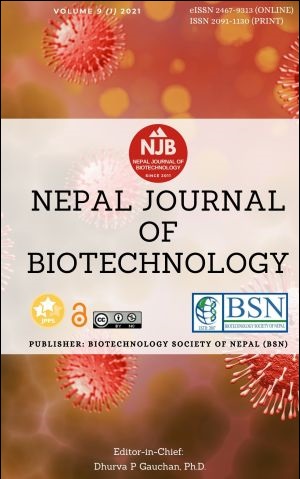Intellectual Property Right on Basmati Rice: Current Scenario and Evidences of Origin, Diversity, Cultivation and Use Values of Basmati Rice in Nepal
DOI:
https://doi.org/10.3126/njb.v9i1.38671Keywords:
Geographical indication, Basmati rice, origin, diversity, Historical literatureAbstract
Basmati rice, also called the king/prince of rice landraces has very special values in Nepalese society as well as in other countries of Indian Subcontinent. With the objectives of collecting, analyzing and documenting Basmati related information in Nepal, we visited different sites; carried out key informant surveys; organized focus group discussions, online interaction and discussion meetings; requested all relevant offices/ persons/ stakeholders through phone, website, and letter to share information; organized high level official meeting, and Basmati rice expert meeting; documented video documentary and did online as well as library search. Because of its high market value at global level, many countries and organizations have been attempting to get intellectual property rights (mainly patent and geographical indication tag) on Basmati rice. India applied for GI tag to Basmati rice in the European Union (EU) in July 2018, and Nepal submitted opposition letter along with proofs and evidences of origin, diversity, cultivation and use values of Basmati rice on 9 December 2020. A total 133 Basmati type rice landraces are grown in 60 districts of Nepal. Basmati rice is traditionally grown, sold, and consumed in geographically localized areas of Nepal since ancient time. International and national scientists have defined lower altitude of Nepal as one of the centers of origin of Basmati rice. Many Nepalese basmati rice landraces have been characterized and evaluated using morphological traits, isozymes and DNA markers. Four basmati type of rice landraces have been registered in National Seed Board. Many community seed banks have maintained different types of Basmati rice landraces. National Agriculture Genetic Resources Center and International genebanks have collected more than 80 and conserved 68 basmati landraces. Basmati rice landraces have geo-linked traits. The historical culture of production, consumption and marketing of native basmati rice in Nepal should always be favored by both national and international rules and regulations. Nepal has ample and valid evidences to get geographical indication (GI) right on Basmati rice.
Downloads
Downloads
Published
How to Cite
Issue
Section
License
Copyright (c) 2021 Biotechnology Society of Nepal

This work is licensed under a Creative Commons Attribution-NonCommercial 4.0 International License.
Copyright Notice:
The manuscript submitted to NJB must be an original contribution, not previously published and should not be under consideration for publication elsewhere. When the manuscript is accepted for publication, the authors agree to automatically transfer the copyright of the article to the publisher. It should grant permission to any third party, in advance and in perpetuity, the right to use, reproduce or disseminate your article, according to the NJB copyright and license agreement.
Authors transfer copyright to the publisher as part of a journal publishing agreement but have the rights to: Share their article for Personal Use, Internal Institutional Use and Scholarly Sharing purposes, with the NJB applies the Creative Commons Attribution-NonCommercial CC BY-NC license to all the works we publish after Jun 2020 (Before it was CC BY-NC-ND). Under this license, authors agree to make articles legally available for reuse, without permission or fees, for virtually any non-commercial purpose. Anyone may remix, adapt, and build upon your work non-commercially, and although their new works must also acknowledge you and be non-commercial, they don’t have to license their derivative works on the same terms. More details on CC BY-NC refer to its Licence Deed and Legal Code.






